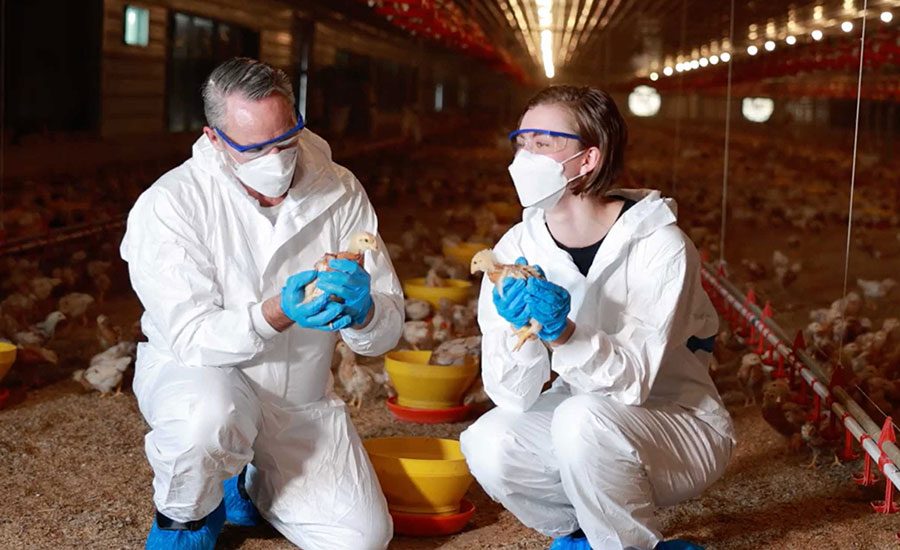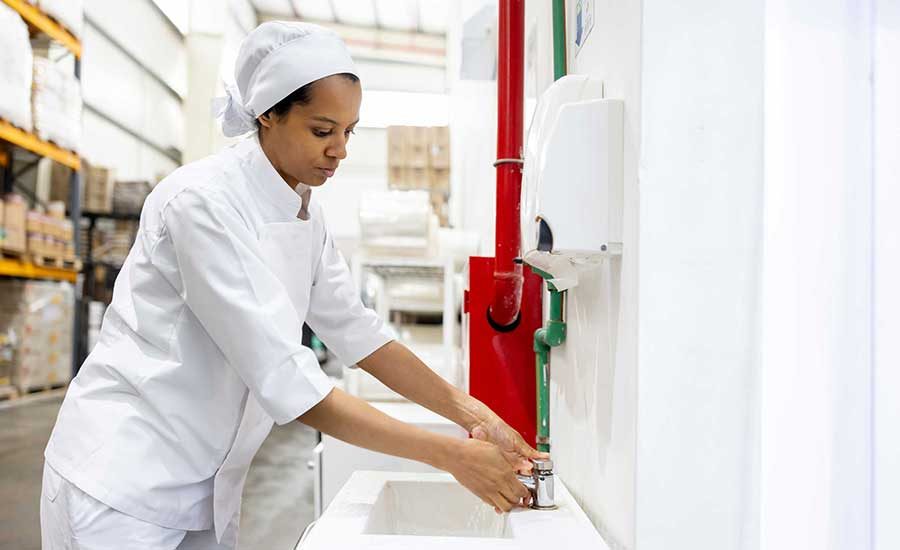Every few weeks there seems to be another major food recall. Is food getting more contaminated or are detection techniques just getting better? Either way, food contamination is an issue that is increasing in concern because of the large costs involved with foodborne illnesses due to contaminated food. Foodborne illnesses cost an estimated $152 billion each year in health-related expenses.[1] The Centers for Disease Control and Prevention (CDC) estimates that each year roughly one out of six Americans (or 48 million people) are affected; 128,000 are hospitalized; and 3,000 die from foodborne diseases.[2] Another factor contributing to increases is that the U.S. is importing more food, and a greater variety is coming from other nations where sanitary standards might not be on par with those in the US.
 Food can become contaminated anywhere along the food chain from growing, harvesting, post-harvest handling, transport, distribution, storage, packaging as well as final preparation at home or in a restaurant. Contamination of produce can occur at the farm from infected seeds, irrigation water, runoff or during the harvesting process. The next major issue is cross-contamination, and this can occur anywhere that batches of food contact potentially contaminated surfaces. This includes transport trucks, storage bins, processing equipment, processing bins as well as the actual processing facility where organisms can hide in conveyors, under equipment, on roof supports, electrical conduits, etc. Since there is a near constant stream of food products passing through these facilities, defining a clear production break is difficult. If contamination is detected, the question of how far back to recall is a difficult question. This is especially difficult if the current decontamination process is not 100% effective.
Food can become contaminated anywhere along the food chain from growing, harvesting, post-harvest handling, transport, distribution, storage, packaging as well as final preparation at home or in a restaurant. Contamination of produce can occur at the farm from infected seeds, irrigation water, runoff or during the harvesting process. The next major issue is cross-contamination, and this can occur anywhere that batches of food contact potentially contaminated surfaces. This includes transport trucks, storage bins, processing equipment, processing bins as well as the actual processing facility where organisms can hide in conveyors, under equipment, on roof supports, electrical conduits, etc. Since there is a near constant stream of food products passing through these facilities, defining a clear production break is difficult. If contamination is detected, the question of how far back to recall is a difficult question. This is especially difficult if the current decontamination process is not 100% effective.
 Some of the major known pathogens that are involved in the contaminations, foodborne illness outbreaks, and food recalls are Salmonella spp., Listeria monocytogenes, and Escherichia coli O157:H7. With new tools such as improved detection methods and product tracking methods, the U.S. Food and Drug Administration has begun an aggressive sampling program. The results are an increase in the recall of products that are contaminated or have the potential of being contaminated. The Amendments Act of 2007[3] and the Food Protection Plan of 2007[4] require food manufacturers to report when an instance occurs and to prove that their product is safe in the event that an expensive recall is necessary. There have recently been some well-known food contamination outbreaks and product recalls. For example, between the months of July and October, 2011, 146 people in 28 different states were infected by L. monocytogenes due to an outbreak from contaminated cantaloupes from Jensen Farms out of Granada, Colorado.[5]
Some of the major known pathogens that are involved in the contaminations, foodborne illness outbreaks, and food recalls are Salmonella spp., Listeria monocytogenes, and Escherichia coli O157:H7. With new tools such as improved detection methods and product tracking methods, the U.S. Food and Drug Administration has begun an aggressive sampling program. The results are an increase in the recall of products that are contaminated or have the potential of being contaminated. The Amendments Act of 2007[3] and the Food Protection Plan of 2007[4] require food manufacturers to report when an instance occurs and to prove that their product is safe in the event that an expensive recall is necessary. There have recently been some well-known food contamination outbreaks and product recalls. For example, between the months of July and October, 2011, 146 people in 28 different states were infected by L. monocytogenes due to an outbreak from contaminated cantaloupes from Jensen Farms out of Granada, Colorado.[5]
This outbreak resulted in the 142 hospitalizations, 30 deaths and 1 miscarriage.[5] As a result, Carol’s Cuts LLC out of Kansas had to recall 594 pounds of cantaloupe, and Fruit Fresh Up, Inc., recalled 4,800 individual packages of fresh cut cantaloupe.[5] Another devastating outbreak that occurred the summer of 2011 was the E. coli O104:H4 outbreak that started in Germany and France due to raw sprouts.[6,7] In this outbreak, 3,126 people were infected, 852 people developed hemolytic uremic syndrome and there were 32 deaths.[6,7] There were a total of six cases with one death within the United States.[6,7] As a result of this outbreak, the farm in Germany where the outbreak started has been shut down even though the true source of the contamination is believed to be from fenugreek seeds that were imported from Egypt.[6]
 Another outbreak that occurred in the summer of 2011 was the ground turkey recall that resulted in a total of 136 persons infected with Salmonella Heidelberg in 34 states.[8] There were 37 hospitalizations and 1 death that occurred as a result of this outbreak.[8] On August 3, 2011, Cargill Meat Solutions Corporation, in Springdale, AR, recalled approximately 36 million pounds of ground turkey products that may have been contaminated with a multi-drug resistant strain of Salmonella Heidelberg, and on September 11, 2011, Cargill Meat Solutions Corporation recalled another 185,000 pounds of ground turkey products after product samples at the plant tested positive for the outbreak strain of Salmonella Heidelberg.[8]
Another outbreak that occurred in the summer of 2011 was the ground turkey recall that resulted in a total of 136 persons infected with Salmonella Heidelberg in 34 states.[8] There were 37 hospitalizations and 1 death that occurred as a result of this outbreak.[8] On August 3, 2011, Cargill Meat Solutions Corporation, in Springdale, AR, recalled approximately 36 million pounds of ground turkey products that may have been contaminated with a multi-drug resistant strain of Salmonella Heidelberg, and on September 11, 2011, Cargill Meat Solutions Corporation recalled another 185,000 pounds of ground turkey products after product samples at the plant tested positive for the outbreak strain of Salmonella Heidelberg.[8]
 The impact of contaminated food has many repercussions. There is the obvious and impactful harm to those who become sick from eating it. There are reduced revenues to growers and producers of that product from reduced demand, even those that were not the cause. There is the disruption of food supply from the recall. Then there is the cost to the company that caused, or at least did not prevent, the actual contamination. While this is always costly, it can be devastating to small and mid-size companies. There is a high probability that they would be forced to go into bankruptcy, destroying the company itself, and forcing the laying off of the workforce. Because of this impact, many facilities have been increasing their sampling tactics to better detect contamination occurrences prior to their becoming major issues. They are also improving their contamination prevention activities (CPAs). Companies are increasing the frequency of washdowns and surface cleanings, as well as investigating new liquid solutions. They are also looking into fumigation methods that can reach into all crevices from floor to ceiling. All decontamination methods can provide kill of organisms in ideal locations if chosen and used properly. To work in a realistic setting and eliminate organisms from floor to ceiling, there must be 1) complete distribution, 2) thorough penetration, 3) a sufficient contact time and 4) a proper concentration with a sterilant. Only fumigation methods have a chance at being able to achieve this goal. Some methods that are being investigated include fogging with liquid disinfectants, fogging with hydrogen peroxide vapor, or fumigating with gasses such as formaldehyde, ozone, or chlorine dioxide. Fogging is quickly discounted because of its physical properties. Typical fog droplets are larger than 5 to 15 microns, which is significantly larger than the organisms (1 or 2 microns) that they are trying to reach. This prevents the fog from getting into crevices that the organisms can be hiding in. The droplets are also much heavier than air so they tend to settle, not getting to high surfaces or beneath equipment. For most liquids to produce the highest level of sporicidal kill, surfaces must also be kept wet for at least 10 hours which also is not very realistic. Vapor-phase hydrogen peroxide (VHP) is also discounted because it has a boiling point of 109°C, which makes it condense out at room temperatures before it can reach all surfaces. This limits the distribution too much to be effective. Ozone is a nice simple technology that can work well in small areas but it breaks down too quickly to be used for large areas. It breaks down before it can reach distant areas from the generation point at high enough concentrations to have effective kill. The only two effective methods for gaseous decontamination available are formaldehyde and chlorine dioxide (CD), but only CD is registered with the Environmental Protection Agency (EPA) as a sterilant process (EPA registration #80802-1). The formaldehyde process requires the heating of paraformaldehyde to release the gas, long contact times (usually 6-12 hours) and high concentrations to achieve a sporicidal outcome (10,000 ppm). Additionally, the residues left by formaldehyde and its carcinogenic properties make it an unattractive choice to be used in areas where food is processed.
The impact of contaminated food has many repercussions. There is the obvious and impactful harm to those who become sick from eating it. There are reduced revenues to growers and producers of that product from reduced demand, even those that were not the cause. There is the disruption of food supply from the recall. Then there is the cost to the company that caused, or at least did not prevent, the actual contamination. While this is always costly, it can be devastating to small and mid-size companies. There is a high probability that they would be forced to go into bankruptcy, destroying the company itself, and forcing the laying off of the workforce. Because of this impact, many facilities have been increasing their sampling tactics to better detect contamination occurrences prior to their becoming major issues. They are also improving their contamination prevention activities (CPAs). Companies are increasing the frequency of washdowns and surface cleanings, as well as investigating new liquid solutions. They are also looking into fumigation methods that can reach into all crevices from floor to ceiling. All decontamination methods can provide kill of organisms in ideal locations if chosen and used properly. To work in a realistic setting and eliminate organisms from floor to ceiling, there must be 1) complete distribution, 2) thorough penetration, 3) a sufficient contact time and 4) a proper concentration with a sterilant. Only fumigation methods have a chance at being able to achieve this goal. Some methods that are being investigated include fogging with liquid disinfectants, fogging with hydrogen peroxide vapor, or fumigating with gasses such as formaldehyde, ozone, or chlorine dioxide. Fogging is quickly discounted because of its physical properties. Typical fog droplets are larger than 5 to 15 microns, which is significantly larger than the organisms (1 or 2 microns) that they are trying to reach. This prevents the fog from getting into crevices that the organisms can be hiding in. The droplets are also much heavier than air so they tend to settle, not getting to high surfaces or beneath equipment. For most liquids to produce the highest level of sporicidal kill, surfaces must also be kept wet for at least 10 hours which also is not very realistic. Vapor-phase hydrogen peroxide (VHP) is also discounted because it has a boiling point of 109°C, which makes it condense out at room temperatures before it can reach all surfaces. This limits the distribution too much to be effective. Ozone is a nice simple technology that can work well in small areas but it breaks down too quickly to be used for large areas. It breaks down before it can reach distant areas from the generation point at high enough concentrations to have effective kill. The only two effective methods for gaseous decontamination available are formaldehyde and chlorine dioxide (CD), but only CD is registered with the Environmental Protection Agency (EPA) as a sterilant process (EPA registration #80802-1). The formaldehyde process requires the heating of paraformaldehyde to release the gas, long contact times (usually 6-12 hours) and high concentrations to achieve a sporicidal outcome (10,000 ppm). Additionally, the residues left by formaldehyde and its carcinogenic properties make it an unattractive choice to be used in areas where food is processed.
CD, ozone, and VHP are oxidizers, but CD is not as aggressive an oxidizer (oxidation potential data) as chlorine, ozone, peracetic acid, hydrogen peroxide or bleach, and it is non-corrosive to common materials of construction, as well as electronics and other sensitive materials. Gaseous CD has none of the mentioned drawbacks associated with the other decontamination methods, it can handle large areas, is compatible with components, equipment and finishings commonly associated with food production facilities. It is a true gas at room temperature; thus is evenly distributed throughout the area being decontaminated by gaseous diffusion. Gaseous CD can penetrate through water allowing for decontamination of the water and the surfaces that the water covers. This is helpful because this saves time from having to completely dry everything after a facility wash-down or cleaning occurs. CD gas also has very quick cycle and aeration times allowing for processing facilities to become fully functional and decontaminated in a shorter period saving both time and money.
 A microbial fumigation of a facility can be completed in 1 to 3 days, depending on a facility’s size and configuration. The setup would consist of sealing all of the possible leaks in an area such as: windows, doors, vents, pipe ways, holes, etc. Additionally, the building exhaust system or HVAC system would need to be controlled in order to contain the CD gas within the facility and/or to exhaust the CD gas at the end of the decontamination cycle. Biological indicators, or spore stripes containing a known value of bacterial spores, can be placed in critical areas to further document the effectiveness of the process. Sample and injection tubing is run to many different points throughout the area so there is representative concentration sampling and even distribution of the gas during the decontamination event. A UV-VIS spectrophotometer continuously and accurately reads the CD concentration throughout the area to ensure that the process parameters are met prior to the cycle being completed. Once the cycle is done and the gas is aerated, the area can be immediately turned back over to production for use.
A microbial fumigation of a facility can be completed in 1 to 3 days, depending on a facility’s size and configuration. The setup would consist of sealing all of the possible leaks in an area such as: windows, doors, vents, pipe ways, holes, etc. Additionally, the building exhaust system or HVAC system would need to be controlled in order to contain the CD gas within the facility and/or to exhaust the CD gas at the end of the decontamination cycle. Biological indicators, or spore stripes containing a known value of bacterial spores, can be placed in critical areas to further document the effectiveness of the process. Sample and injection tubing is run to many different points throughout the area so there is representative concentration sampling and even distribution of the gas during the decontamination event. A UV-VIS spectrophotometer continuously and accurately reads the CD concentration throughout the area to ensure that the process parameters are met prior to the cycle being completed. Once the cycle is done and the gas is aerated, the area can be immediately turned back over to production for use.
Food facilities typically either use steam or wash as many surfaces as possible with an anti-microbial solution in an attempt to kill as many possible contaminating microorganisms. Some microorganisms typically survive the process either because the agent did not reach them at the proper concentration for the correct amount of time or due to mechanisms that they develop to cope with some sanitizers, cleaning agents and temperatures. Other dry facilities do no routine actions to eliminate organisms. If microorganisms are not being completely removed, they can slowly build up their population and spread over larger areas making the chances of a contamination much higher. Gaseous CD will completely eradicate the microorganisms. By using CD as a frequent and routine method for decontaminating a facility before an issue arises, the chances of a contamination and/or a recall decline drastically thus potentially saving money, disruptions to business, and perhaps lives.
For more information, please visit www.clordisys.com.
References
1. www.producesafetyproject.org /admin/assets/files/Health-Related-Foodborne-Illness-Costs-Report.pdf-1.pdf. Accessed on: 05/13/2010.
2. www.cdc.gov/foodborneburden/2011-foodborne-estimates.html.
3. www.fda.gov/Food/GuidanceComplianceRegulatoryInformation/GuidanceDocuments/FoodSafety/ucm180761.htm.
4. www.fda.gov/Food/FoodSafety/FoodSafetyPrograms/FoodProtectionPlan2007/ucm132705.htm.
5. www.cdc.gov/salmonella/heidelberg/111011/index.html.
6. www.cdc.gov/listeria/outbreaks/cantaloupes-jensen-farms/120811/index.html.
7. www.efsa.europa.eu/en/efsajournal/pub/2390.htm.
8. www.cdc.gov/ecoli/2011/ecoliO104/index.html.
Image captions
Image 1: From www.knowabouthealth.com/salmonella-outbreak-prompts-recall-of-13-popular-egg-brands/5586/.
Image 2: From www.webmd.com/food-recipes/food-poisoning/ss/slideshow-food-poisoning-dangers.
Image 3: From www.telegraph.co.uk/foodanddrink/foodanddrinknews/8598821/E.coli-consumers-advised-not-to-eat-raw-bean-sprouts.html.
Image 4: From www.fox44.com/news/ground-turkey-recall-due-to-salmonella.
Image 5: From atrp.gatech.edu/pt19v3f07/19-3_p1.html.
Reducing Food Recalls with Microbial Fumigation of Food Processing Facilities
Looking for a reprint of this article?
From high-res PDFs to custom plaques, order your copy today!





